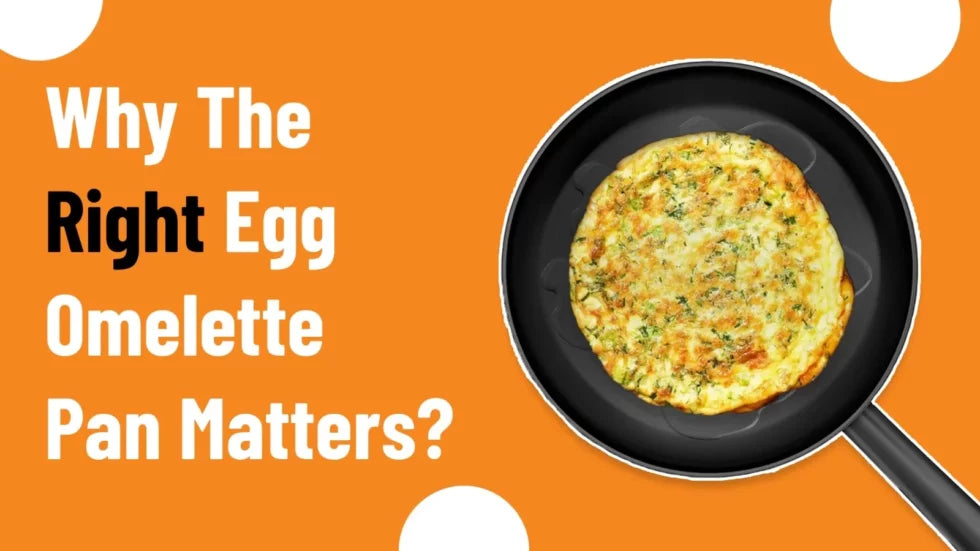I sometimes wonder why my near 'omelette wale bhaiya' stabs the pan so hard. How does he make that fluffy yet crispy omelette while mine feels more like a scrambled egg misadventure?
Well, guess what I found! It's not that they're using eggs laid by chickens with PhDs in Advanced Yolk Engineering (lol). It is because they have the right egg omelette pan.
Yes, the pan! And guess what? Today, I'm revealing why choosing the best omelette pans can be a game-changer in your morning breakfast:
What is the Difference Between a Normal Pan and an Omelette Pan?
Imagine this: You're ready to buy eggs online and embark on your omelette adventure. You may think a pan is a pan. But in the world of omelettes, not all pans are created equal. While both warriors (Normal Pan and Omelette Pan) can win the war against your morning hunger. However, they've got different battle skills (aka features) that set them apart:

Shape:
- Ordinary Pan: Generally has straight, vertical sides, making it versatile for various cooking tasks.
- Omelette Pan: Specifically designed with sloping sides to make it easier to slide a finished omelette onto a plate. This design aids in quickly flipping or folding an egg omelette, especially an egg white omelette.
Material:
- Ordinary Pan: This may come in various materials such as cast iron, stainless steel, or non-stick.
- Omelette Pan: Most commonly made with non-stick material to ensure that the omelette, including a delicate egg white omelette, does not stick to the pan, allowing for a flawless flip.
Size:
- Ordinary Pan: Typically larger and suitable for many cooking tasks, not just limited to eggs.
- Omelette Pan: Smaller in diameter, designed to cook omelettes effectively, using farm fresh eggs or 100% fresh eggs for optimal results.
Heat Distribution:
- Ordinary Pan: Heat distribution can vary, depending on the material. Some materials, like cast iron, retain heat well but may not distribute it as evenly.
- Omelette Pan: Designed for quick and even heat distribution, essential for cooking an omelette perfectly.
Why Does an Omelette Stick to a Non-Stick Pan?
While being ready with 100% farm-fresh eggs bought online and checking countless YouTube tutorials and online reviews, I finally decided to make the best non-stick egg omelette using a non-stick pan I purchased previously.
The First Flip: Feeling like a professional chef, I cracked those eggs, whipped them into a mix, poured them into the pan and waited for the perfect moment to execute the first flip. But then, disaster happened. The beautiful, half-formed omelette stubbornly clung to the pan! How? Why?
The Great Culinary Investigation: Determined to solve the mystery, Let’s get in depth into the world of non-stick pans:
- The Heat Conundrum: It was a mistake to assume that high heat would do the job faster. When an egg frying pan gets too hot, it can cause eggs to stick. Extremely high temperatures break down the non-stick coating, making it less "non-stick."
- The Oil Oversight: While non-stick pans are designed to require less oil, a light coating can still make a world of difference. Certain oils, like extra virgin olive oil, complement the pan's surface, ensuring the omelette flips effortlessly.
- Deteriorated Non-Stick Coating: Non-stick pans have a magical allure. They provide an easy cooking and cleanup experience. But with time, the coating can deteriorate due to abrasive cleaning, overheating or just regular wear and tear.
Hacks to Keep Eggs from Sticking
Once you have decided to buy white eggs online or maybe brown eggs online, now, it's time to ensure these protein-packed gems slide onto your plate. Here is a guide for giving your omelette the non-stick treatment it deserves:
- Preheat, but Don't Overheat: Turn on your stove to medium and give your egg frying pan 2-3 minutes to warm up evenly. A preheated pan is less likely to make your omelette a sticky mess.
- Season the Pan: Rub a little oil over the surface of your pan before adding your eggs. You can also use a non-stick cooking spray if you prefer.
- Keep It Moving: When your eggs hit the pan, stir gently with a silicone or wooden spatula. This not only prevents sticking but also contributes to the fluffiness of your omelette.
- Invest in Quality: If you love omelettes, don't skimp on your egg omelette pan. Invest in a quality one that will pay dividends through countless flawless breakfasts.
Final Thoughts
So, do you still think all pans are created equal? By choosing the right egg omelette pan, you're on your way to achieving the best omelette breakfast. With your newfound pan wisdom, why not upgrade your egg game? Order farm fresh eggs online at the best prices from Eggoz Nutrition that offers richer flavour, brighter yolks, and higher nutrients. After all, your world-class omelette pan deserves world-class eggs. Happy cooking!
FAQs
Can I make my omelette with olive oil instead of butter?
Of course! Olive oil may add a distinct flavour to your omelette and is a healthier fat choice. Just watch out that using extra virgin olive oil on high heat will cause it to smoke and give your eggs a harsh flavour.
Where can I get the greatest omelette eggs?
Eggoz Nutrition is one place to buy farm-fresh eggs at the best prices. We also provide home delivery to make it convenience-friendly.
How to clean an omelette pan without damage?
Metal scouring pads, harsh chemicals, and dishwasher use can harm the non-stick coating. Soak the pan in warm, soapy water to loosen food residue before washing. You may enjoy excellent, non-stick omelettes for years with proper care.


